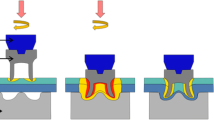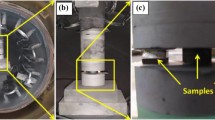Abstract
This paper is concerned with experiments and finite element (FE) simulations using the coupled Eulerian‒Lagrangian (CEL) method for multi-material joining by the flow drill screw (FDS) process. The FDS joining experiments involved various combinations of aluminum alloys (Al6061-T6 2.0t and Al6063-T6 2.0t), and steel (SPRC45E 1.6t) sheets. During the FDS joining, thermocouples and a thermal imaging camera, FLIR, were used to measure the elevated temperature near the joint. Cross-sections of the multi-material joint specimens were prepared to check the joining quality and the deformed shape of the materials. To consider the complexity of the joining process and convergence issue of numerical simulation, the FE modeling approach for the FDS joining was constructed based on the CEL method using the ABAQUS/Explicit, considering the strain rate and thermal softening dependent strain hardening of each material. From the comparison of experimental and FE simulation results, the reliability of the FE modeling was validated, revealing the predictability of the deformed shape was 90% or more, especially in terms of the bushing length. Furthermore, it was confirmed that the proposed modeling approach can accurately describe the temperature history and peak values during rapid joining.


















Similar content being viewed by others
Change history
06 March 2024
A Correction to this paper has been published: https://doi.org/10.1007/s12289-024-01821-3
References
Sigler DR, Carlson BE, Janiak P (2013) Improving aluminum resistance spot welding in automotive structures. Weld J 92:64–72
Hu S, Haselhuhn AS, Ma Y et al (2021) Sensitivity of dissimilar aluminum to steel resistance spot welds to weld gun deflection. J Manuf Process 68:534–545
Pouranvari M (2017) Critical assessment 27: dissimilar resistance spot welding of aluminium/steel: challenges and opportunities. Mater Sci Technol 33:1705–1712
Mori K, Abe Y (2018) A review on mechanical joining of aluminium and high strength steel sheets by plastic deformation. Int J Lightweight Mater Manuf 1:1–11
Hoang N-H, Porcaro R, Langseth M, Hanssen A-G (2010) Self-piercing riveting connections using aluminium rivets. Int J Solids Struct 47:427–439
Maji P, Karmakar R, Nath RK, Paul P (2022) An overview on friction stir welding/processing tools. Mater Today: Proc 58:57–64
Thomas W, Nicholas E, Needham J et al (1991) Improvements to friction welding. GB Patent App 23:9125978
Meschut G, Janzen V, Olfermann T (2014) Innovative and highly productive joining technologies for multi-material lightweight car body structures. J Mater Eng Perform 23:1515–1523
Lennon R, Pedreschi R, Sinha B (1999) Comparative study of some mechanical connections in cold formed steel. Constr Build Mater 13:109–116
Cai W, Wang P, Yang W (2005) Assembly dimensional prediction for self-piercing riveted aluminum panels. Int J Mach Tools Manuf 45:695–704
Eshtayeh M, Hrairi M, Mohiuddin A (2016) Clinching process for joining dissimilar materials: state of the art. Int J Adv Manuf Technol 82:179–195
Aslan F, Langlois L, Mangin P, Balan T (2018) Identification of drilling parameters during the flow drill screw driving process. Key Eng Mater 767:465–471
Aslan F, Langlois L, Balan T (2019) Experimental analysis of the flow drill screw driving process. Int J Adv Manuf Technol 104:2377–2388
Skovron J, Mears L, Ulutan D et al (2015) Characterization of flow drill screwdriving process parameters on joint quality. SAE Int J Mater Manuf 8:35–44
Skovron JD, Rohan Prasad R, Ulutan D et al (2015) Effect of thermal assistance on the joint quality of Al6063-T5A during flow drill screwdriving. J Manuf Sci Eng 137:051019
Sønstabø JK, Holmstrøm PH, Morin D, Langseth M (2015) Macroscopic strength and failure properties of flow-drill screw connections. J Mater Process Technol 222:1–12
Pan J, Chen W-N, Sung S-J et al (2018) Failure mode and fatigue behavior of flow drill screw joints in lap-shear specimens of aluminum 6082–T6 sheets of different thicknesses. SAE Int J Mater Manuf 11:315–326
Hong SH, Yan F, Sung S-J et al (2016) Investigation of failure mode and fatigue behavior of flow drill screw joints in lap-shear specimens of aluminum 6082–T6 sheets. SAE Int J Mater Manuf 9:746–750
Szlosarek R, Karall T, Enzinger N et al (2013) Mechanical testing of flow drill screw joints between fibre-reinforced plastics and metals. Materials Testing 55:737–742
Kim J, Lee H, Choi H et al (2020) Prediction of load–displacement curves of flow drill screw and RIVTAC joints between dissimilar materials using artificial neural networks. J Manuf Process 57:400–408
Sønstabø JK, Morin D, Langseth M (2018) Static and dynamic testing and modelling of aluminium joints with flow-drill screw connections. Int J Impact Eng 115:58–75
Sønstabø JK, Morin D, Langseth M (2018) Testing and modelling of flow-drill screw connections under quasi-static loadings. J Mater Process Technol 255:724–738
Costas M, Morin D, Sønstabø JK, Langseth M (2021) On the effect of pilot holes on the mechanical ehaviour of flow-drill screw joints. Experimental tests and mesoscale numerical simulations. J Mater Process Technol 294:117133
Liu W, Zhu X, Zhou Q et al (2020) Modeling and simulation of the flow drill screw process of a DP590/Al6061-T6 multi-material joint used for vehicle body. Int J Adv Manuf Technol 110:1189–1201
Beni YT, Movahhedy M (2010) Consistent arbitrary Lagrangian Eulerian formulation for large deformation thermo-mechanical analysis. Mater Des 31:3690–3702
Tandis E, Ashrafizadeh A (2021) Numerical simulation of weakly compressible hyper-elastic solids using a conservative pressure-velocity formulation on arbitrary Lagrangian-Eulerian framework. Appl Math Model 96:796–812
Aval HJ (2021) Comprehensive thermo-mechanical simulation of friction surfacing of aluminum alloys using smoothed particle hydrodynamics method. Surf Coat Technol 419:127274
Demiral M (2014) 1365. Smoothed particle hydrodynamics modeling of vibro-assisted turning of Ti alloy: influence of vibration parameters. J Vibroeng 16:2685–2694
Ambrosio D, Tongne A, Wagner V et al (2022) A new damage evolution criterion for the coupled Eulerian-Lagrangian approach: Application to three-dimensional numerical simulation of segmented chip formation mechanisms in orthogonal cutting. J Manuf Process 73:149–163
Foucard L, Aryal A, Duddu R, Vernerey F (2015) A coupled Eulerian-Lagrangian extended finite element formulation for simulating large deformations in hyperelastic media with moving free boundaries. Comput Methods Appl Mech Eng 283:280–302
Wu CT, Wu Y, Lyu D et al (2020) The momentum-consistent smoothed particle Galerkin (MC-SPG) method for simulating the extreme thread forming in the flow drill screw-driving process. Comp Part Mech 7:177–191
Grujicic M, Snipes J, Ramaswami S (2017) Process modeling, joint virtual testing and construction of joint connectors for mechanical fastening by flow-drilling screws. Proc Inst Mech Eng, Part B: J Eng Manuf 231:1048–1061
Park N, Stoughton TB, Yoon JW (2019) A criterion for general description of anisotropic hardening considering strength differential effect with non-associated flow rule. Int J Plast 121:76–100
Park N, Stoughton TB, Yoon JW (2020) A new approach for fracture prediction considering general anisotropy of metal sheets. Int J Plast 124:199–225
Bang J, Park N, Song J et al (2021) Tool wear prediction in the forming of automotive DP980 steel sheet using statistical sensitivity analysis and accelerated U-bending based wear test. Metals 11:306
Lee H-R, Lee M-G, Park N (2022) Incremental tube forming process with a novel free rotating bearing tool tip: experiment and FE modeling with anisotropic plasticity model. Met Mater Int 28:2356–2370
Jung S-H, Bae G, Kim M et al (2022) Effect of natural aging time on anisotropic plasticity and fracture limit of Al7075 alloy. Mater Today Commun 31:103553
Lesuer DR, Kay GJ, LeBlanc MM (2001) Modeling large-strain, high-rate deformation in metals (No. UCRL-JC-134118). Lawrence Livermore National Lab (LLNL), Livermore, CA (United States)
Park N, Song Y, Jung S-H et al (2021) Numerical and experimental investigation on the surface defect generation during the hot extrusion of Al6063 alloy. Materials 14:6768
Lin Y, Chen M-S, Zhong J (2008) Constitutive modeling for elevated temperature flow behavior of 42CrMo steel. Comput Mater Sci 42:470–477
Lee HJ (2006) The dynamic tensile tests of auto-body steel sheets with the variation of temperature for material constitutive equations. Master’s thesis. Korea Advanced Institute of Science and Technology, Daejeon, South Korea
Lee EH, Rubin MB (2020) Modeling anisotropic inelastic effects in sheet metal forming using microstructual vectors–Part I: Theory. Int J Plasticity 134:102783
Lee EH, Rubin MB (2021) Modeling inelastic spin of microstructural vectors in sheet metal forming. Int J Solids Struct 225:111067
Lee EH, Rubin MB (2022) Eulerian constitutive equations for the coupled influences of anisotropic yielding, the Bauschinger effect and the strength-differential effect for plane stress. Int J Solids Struct 241:111475
Lee EH (2023) Correlation between parameters in the microstructural vector theory and Hill’s plastic potential. Appl Math Model 124:192–215
Lin C-H, Hung C, Hsu T-Y (2020) Investigations of granular material behaviors using coupled Eulerian-Lagrangian technique: From granular collapse to fluid-structure interaction. Comput Geotech 121:103485
Qiu G, Henke S, Grabe J (2011) Application of a Coupled Eulerian-Lagrangian approach on geomechanical problems involving large deformations. Comput Geotech 38:30–39
Available online: https://abaqus-docs.mit.edu/2017/English/SIMACAECAERefMap/simacae-c-adveulerianeela.htm. Accessed 10 Feb 2022
MatWeb-Online Materials Information Resource. http://www.matweb.com/. Accessed 15 Feb 2022
Acknowledgements
The authors gratefully appreciate the support from the Korea Institute of Industrial Technology as part of the “Development of root technology for multi-product flexible production (KITECH EO-23-0008)”.
Author information
Authors and Affiliations
Corresponding author
Ethics declarations
Conflict of interest
The authors declare that they have no conflict of interest.
Additional information
Publisher's Note
Springer Nature remains neutral with regard to jurisdictional claims in published maps and institutional affiliations.
The original online version of this article was revised: there is serious damage in Fig.15 ("black background"), which appears to have been corrupted during the upload process.
Rights and permissions
Springer Nature or its licensor (e.g. a society or other partner) holds exclusive rights to this article under a publishing agreement with the author(s) or other rightsholder(s); author self-archiving of the accepted manuscript version of this article is solely governed by the terms of such publishing agreement and applicable law.
About this article
Cite this article
Kim, M., Kim, S. & Park, N. Rapid multi-material joining via flow drill screw process: experiment and FE analysis using the coupled Eulerian‒Lagrangian method. Int J Mater Form 17, 6 (2024). https://doi.org/10.1007/s12289-023-01800-0
Received:
Accepted:
Published:
DOI: https://doi.org/10.1007/s12289-023-01800-0




